Introduction
As urban communities grow, design and management strategies for new developments become critical factors that determine impacts on natural resources (Figure 1). How can we accommodate growth and yet conserve natural resources such as biodiversity, water, and energy? In this document, we focus on conserving biodiversity when land is subdivided. The term biological diversity, or biodiversity, refers to the variety of life and its processes. Biodiversity includes species diversity, habitat diversity, and genetic diversity. For the purposes of this article, we focus on biodiversity conservation of native species. Native species in the United States are plants and animals that were present within a specific region before Europeans made first contact. Non-native (or exotic) plants or animals are defined as those species that were not present in the region before European contact.
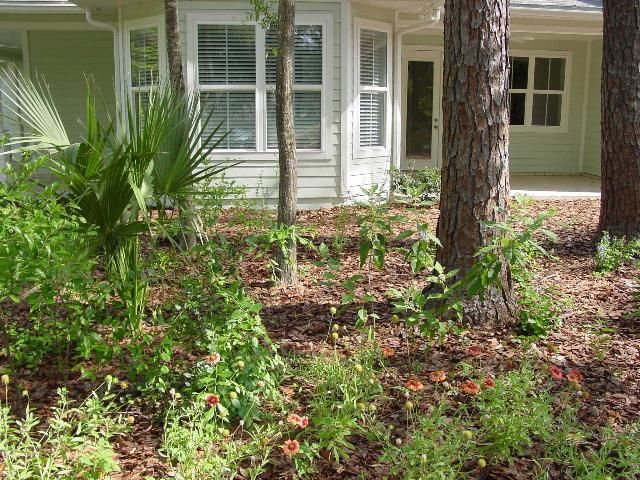
Credit: Mark Hostetler, UF/IFAS
Recently, a popular concept called cluster development, conservation subdivision, or conservation development (CD) has gained traction in many planning and design fields. Conservation development is intended to accommodate growth while simultaneously managing for biodiversity conservation. Typically in CDs, homes are clustered on small lots with the remaining land areas conserved as open space, as opposed to traditional development, where homes are spread out, fragmenting the original natural areas.
The goals for CD are twofold: 1) to maintain and improve biodiversity within a designated subdivision; and 2) to minimize development-related impacts on surrounding habitats. Often, though, the efforts are limited to just the initial phase of development: site design. To conserve and improve biodiversity within urban environments effectively, one must consider the following three phases of development: design, construction, and post-construction. Overall, these three phases must be addressed in order to create and maintain biodiversity within residential subdivisions. The "Conservation Subdivision" series of EDIS publications discusses biodiversity conservation pertaining to all three phases of development. This fact sheet focuses on decisions made in the third phase: post-construction.
The design phase typically involves, among other aspects, lot size and open space designation and road distribution throughout the site. Goals for the development are discussed and prioritized. In this phase, homes and lots are placed across the site, and the remaining area is designated as natural open space. Basically, everything is laid out on paper and vertical structures (buildings) and horizontal structures (roads, lots, conserved areas, and shared spaces) are given specific spaces within the development, while remaining areas are designated as natural open space (often in environmentally sensitive areas such as wetlands and mature forests).
Next, during the construction phase, built environment professionals including architects, contractors, and subcontractors take whatever is on paper and implement it on the ground, constructing homes, streets, waste treatment systems, and landscaped areas such as lots and parks. In the absence of fully trained or engaged contractors or landscapers, many things can happen during this phase that could destroy or decrease the viability of onsite and nearby natural habitat. For example, even if the most important large trees are planned to be preserved across the subdivision and built areas are designed around them, the placement of topsoil and routes used by heavy construction vehicles could impair the survival of these trees. If heavy construction vehicles continually run over the root zones of trees or if topsoil is placed against their trunks, the roots may not be able to acquire nutrients, water, and oxygen, and the trees may die.
In the final phase, post-construction, buyers purchase the homes and move into the community. It is now the responsibility of residents individually and collectively to manage their homes, yards, neighborhoods, and common areas in ways that do not compromise the original intent of the community. Additional problems can arise if residents are not fully engaged—imagine residents moving in and planting invasive exotic plants in each of their yards. Residents could also improperly apply fertilizers and pesticides. The spread of invasive plants and polluted stormwater runoff could then severely reduce or destroy the diversity of animals and plants found in the conserved areas.
Simply designating open space is not enough to provide long-term protection for a variety of wildlife (McElfish 2004; Hostetler and Drake 2009; Hostetler 2010). There is limited evidence for CDs maintaining biodiversity over the long term, and some studies suggest that existing CDs fail to provide better wildlife habitat than conventional subdivisions (Lenth et al. 2006; Milder et al. 2008). As noted above, impacts stemming from built areas could compromise the intent of the CD to conserve biodiversity. Researchers and practitioners suggest that in order for a CD to maintain long-term biodiversity, it needs to have a management plan that assigns stewardship responsibilities to residents or outside entities such as a land trust (Arendt 1996; Pejchar et al. 2007).
In another UF/IFAS document, Conservation Subdivision: Post-construction Phase--Engaging Residents, we discuss the importance of engaging residents in CDs in order to conserve natural resources. In that article, we suggest that installing educational signs is one way to increase awareness and participation in conservation activities. However, we do not give examples or methods on how to create and install these signs in neighborhoods. In the present article, we provide those methods and examples and discuss how to create educational signs and install them in residential neighborhoods as a way to inform residents about biodiversity conservation. Although we concentrate on biodiversity conservation, these signs could address any natural resource conservation issue.
Creating a New Norm: Getting Conservation Information into Neighborhoods
Installing educational signs in common spaces of neighborhoods can engage and inform residents about biodiversity conservation. These signs could discuss a variety of conservation issues pertaining to homes, yards, and neighborhoods such as biodiversity conservation, water and energy conservation, and even information about particular wildlife species. Below, we discuss our experiences with creating and installing such educational signs.
I. Design and Management of Signs
We wanted to create a sign that was durable and allowed educational information to be changed out. We have found that interchangeable education panels that insert into the sign were critical for several reasons. First, a typical sign has the same content residents see each day, but we wanted the ability to keep information fresh and to display different education topics throughout the years. Also, in Florida and elsewhere, the panels will eventually fade from sunlight (or get damaged by vandals) and we wanted an affordable way to replace them. If you use a sign that is not interchangeable, when it fades or gets damaged, you must replace the whole unit. This is very expensive! Switching out panels is more cost effective because the panels are easier to reproduce.
Where does one get a sign that allows educational panels to be switched out? It helps to know the industry terminology, first of all. We discovered that the companies that make these things call them "graphic display units." We tried several models and finally settled on the one pictured (Figures 2 and 3). The display unit is all-aluminum, so it will not rust, and the top of it is removable to allow you to slide your educational panel into place. It took us a considerable time to find a display unit that was fairly inexpensive and interchangeable. There are several companies that make them, but we finally settled on one called Pannier www.panniergraphics.com (no endorsement implied). Sign companies will have all types of standard models for you to choose from. Costs per display unit vary, depending on how many ordered and type of unit, but it is usually about $450 per unit.
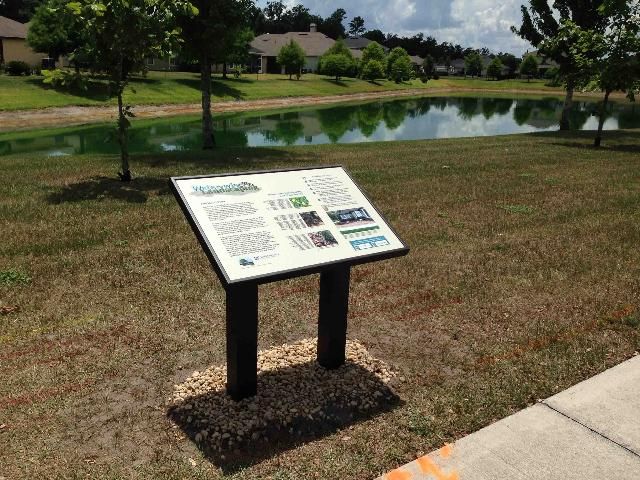
Credit: Mark Hostetler, UF/IFAS
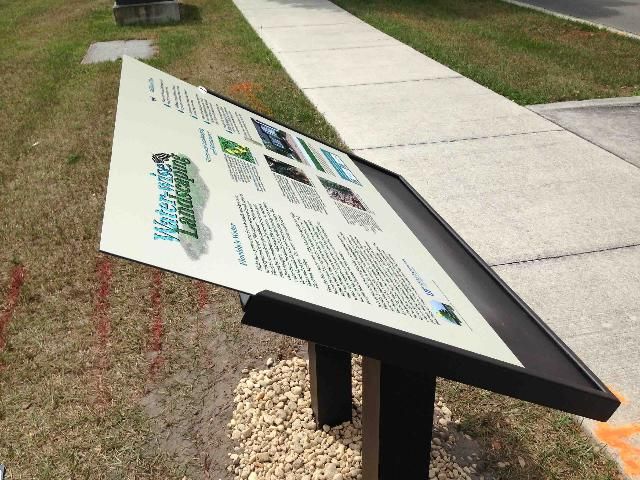
Credit: Mark Hostetler, UF/IFAS
The panels are usually printed on a hard material such as aluminum or some hard plastic composite with a clear overlaminate to protect the ink from fading and scratches. We went with a local sign company that printed full color (35" X 23") panels on 3/16" aluminum backing with a clear overlaminate for us. They cost about $100 each. Once they are printed, you can switch out the panels over and over. It is possible to save money in the short term by printing posters on a softer material with overlaminate coating, but in most cases these will end up costing more because they tend to bubble up and warp if the sign is mounted in an area that receives full sun. A sturdy backing will resist buckling and warping, and it will be thick enough to fit snugly into the slot. If you do print on thinner media (less than 3/16" thick), you will need to place some hard backing behind the thin panel to fill the gap between the frame and the panel so that the panel does not slide around.
We recommend an all-aluminum graphic display unit. It is much more durable and sturdy than one with wooden backing and posts. A couple of signs that we installed with a wooden backing began to break down after 7 years. All-aluminum framing resists the elements better than wood.
We recommend installing more than one sign. Scatter them in different areas throughout the subdivision in order to display more information and create interest. For the neighborhood in Gainesville, we installed one sign near a pool (Figure 4) and the other by a sidewalk along a road where children are picked up by a school bus (Figure 2). In the Town of Harmony, Florida, we installed 7 signs, and each one had a theme (e.g., water, energy, wildlife, landscaping, insects/pollinators, lakes, and natural/human history). We wondered whether these neighborhood signs would be vandalized, and we found that it depends on the neighborhood. Our signs in the town of Harmony stayed in place for over 8 years with no significant damage from residents.
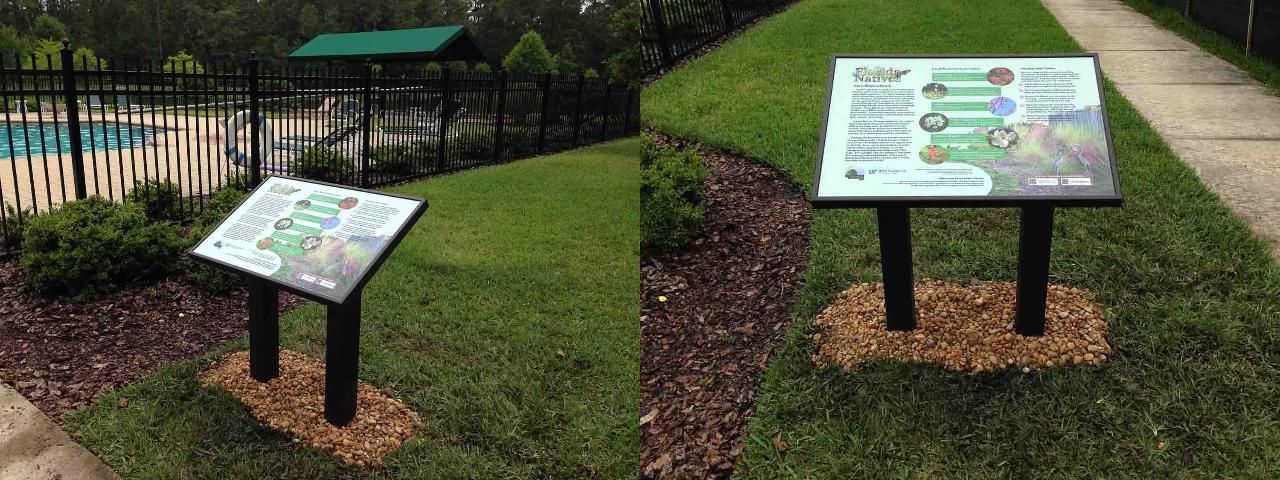
Credit: Mark Hostetler, UF/IFAS
As for each individual panel, you can organize the content the way you like, but we found that information organized in three sections seems to offer a variety of information in a readable way. The first section is usually a little background information about the topic, the middle section highlights an interesting fact or goes more in depth about an issue, and the third section usually describes what people can do or provides tips. In the alligator panel example (Figure 5), the left section gives background information about alligators and describes issues associated with them living in urban areas; the middle section highlights some interesting facts about alligators (courtship and nesting); and the right section tells what people can do to lessen conflicts with alligators.
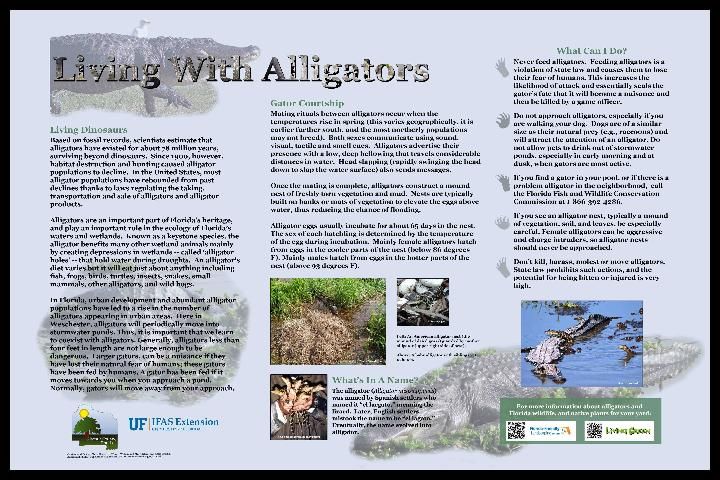
Credit: Meryl Klein and Mark Hostetler, UF/IFAS
We also printed QR codes for people to scan and access more information on a website. On the alligator panel (Figure 5), the lower right has two QR codes—one for a Living Green website and the other for a Florida-Friendly Landscaping website. We wanted to count the number of visits to these websites from people scanning the signs in the neighborhood; there is a procedure for this. Instead of describing in detail on how to make a QR code and track it, instructions can be found here. We made different QR codes for different developments so we could track where the website visits are coming from.
For upkeep and maintenance of the signs, we recommend working with a local neighborhood club, the homeowner association, or a diligent homeowner. We have found that turning over responsibility of the upkeep of the signs to the neighborhood helps to foster ownership of the signs—not to mention that it reduces the number of trips you have to make to a neighborhood! Further, panels need to be reprinted and new ones made; thus, a long-term funding source, such as homeowner association dues, is needed for sign upkeep. The graphic display unit can last indefinitely because of the aluminum frame and posts. Individual, printed panels can last 10 years or more if they are maintained properly.
We cannot stress enough the importance of turning over responsibility for the signs to the neighborhood. Extra panels need to be stored somewhere and we recommend finding one or two local homeowners to watch the display units and be able to switch out the education panels (Figure 6). Also, the local landscaping company needs to be informed and aware about upkeep of the signs. Weed whacking around the base of these signs can cause significant damage and lawn care companies need to be aware of maintenance issues around the signs. In particular, the example shown in Figure 2 (the water-wise landscaping sign) has been significantly soiled by a pair of northern mockingbirds, who have taken to perching on the sign and defecating on it. When a lawn care person or a local homeowner comes by, it is a simple matter of wiping the bird droppings off the sign every now and then.
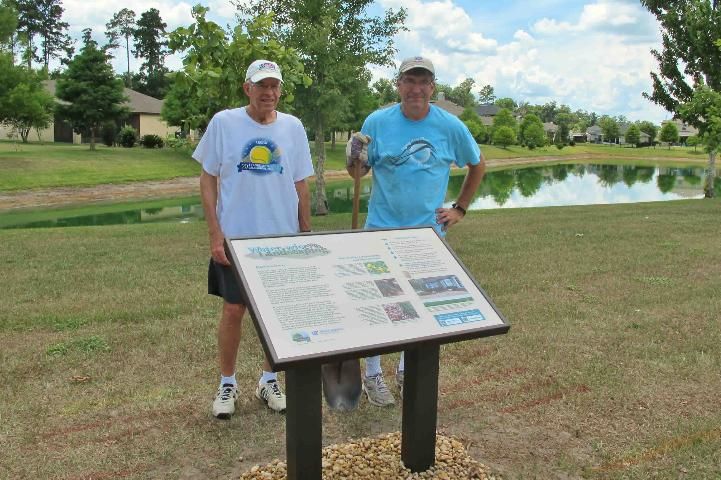
Credit: Jeanette Hostetler, UF/IFAS
II. Highlighting a Local Steward
One way to generate enthusiasm both for the signs and for the overall mission of a conservation subdivision is to find a resident in the neighborhood who has implemented conservation practices and then highlight the person's successes on the panel, inviting people to contact this homeowner or visit their yard. The trick is to find a maverick homeowner who has done something sustainable and is proud of it and willing to share the success story with neighbors.
We have installed this educational sign (Figure 7) that includes landscaping from a local homeowner. We will follow-up to see if anybody has contacted the homeowner about the yard and whether any neighbors have begun to install native plants. The idea is that a local, knowledgeable homeowner can affect change much better than outside experts coming in and talking with only a few residents.
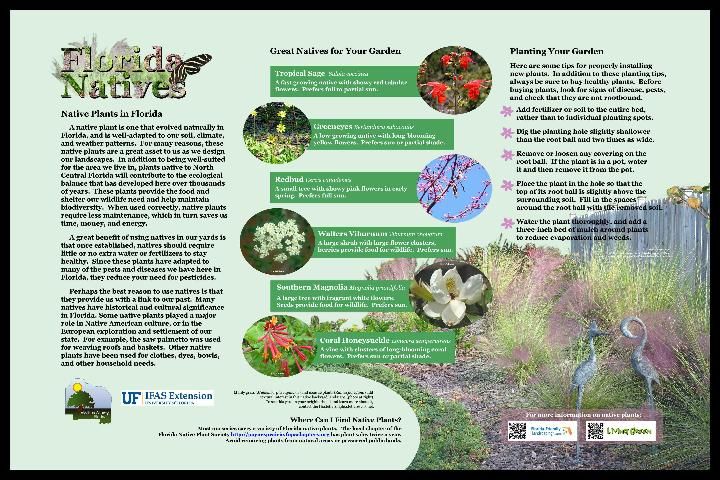
Credit: Meryl Klein and Mark Hostetler, UF/IFAS
III. Do these signs work?
Is all this effort getting results? Are we improving environmental attitudes, knowledge, and behaviors? In collaboration with graduate students from the Department of Wildlife Ecology and Conservation at the University of Florida, we evaluated the impact of a new environmental education program installed in a green community, the town of Harmony, Florida, consisting of educational signs, a website, and a brochure. We evaluated whether Harmony residents' environmental knowledge, attitudes, and behaviors improved when compared to residents of a conventional community. After two years of exposure to the program, Harmony homeowners did show significant improvement in some environmental knowledge, attitudes, and behaviors, and the control community did not (Hostetler et al. 2008). In particular, we found that most residents saw and read the educational signs and relatively fewer homeowners visited the website and/or read the brochure. Such signs can help homeowners understand ways to manage their homes, yards, and neighborhoods in a more sustainable manner. To see examples of these signs, visit https://wec.ifas.ufl.edu/extension/gc/harmony/documents/wildsidewalk.pdf.
Conclusions
To be successful, biodiversity conservation designs for urban communities must engage the local residents. Urban natural remnants will continue to serve the ecosystem only as long as their ecological functions are protected and preserved, and that takes informed, committed neighbors. Conservation design and management practices in homes, yards, and neighborhoods will not remain viable if residents in these areas do not understand and value them and want to participate in them. We encourage municipalities to create policies that require or provide incentives to install educational signs, particularly in "green developments" that have intentions to conserve natural resources. Also, these informative signs could be installed in neighborhoods and city parks that are immediately adjacent to critical natural areas, informing users about behaviors that could have both positive and negative consequences.
We do understand that these educational signs may be only one step down a path towards a sustainable community, and signs may not be enough if there are significant barriers in city policies and even in deed restrictions placed on homes in a neighborhood. For example, some deed restrictions require 60% lawn in the front, monitored by a homeowner association. The signs may raise awareness and confidence for homeowners to implement conservation actions (e.g., planting natives), but if significant barriers exist in city or in homeowner association oversight, citizens' ability to improve their environment may be limited. Nevertheless, we hope to have highlighted some important steps to take in order to install a successful and long-lasting sign/education program to help engage residents to conserve natural resources.
Additional Resources
For additional information on conservation subdivisions and conserving urban biodiversity, a variety of online guides, books, and other publications exist.
Books and Scientific Publications
Arendt, R. 1996. Conservation design for subdivisions: A practical guide to creating open space networks. Washington, DC: Island Press.
Hostetler, M., and D. Drake. 2009. "Conservation subdivisions: A wildlife perspective." Landscape and Urban Planning 90:95–101.
Hostetler, M.E. 2010. "Beyond design: the importance of construction and post-construction phases in green developments." Sustainability 2:1128–1137.
Hostetler, M. E. 2012. The Green Leap: A Primer for Conserving Biodiversity in Subdivision Development. Berkeley, CA: University of California Press.
Hostetler, M., E. Swiman, A. Prizzia, and K. Noiseux. 2008. Reaching residents of green communities: Evaluation of a unique environmental education program. Applied Environmental Education & Communication 7(3):114–124.
Lenth, B. A., R. L. Knight, and W. C. Gilgert. 2006. "Conservation value of clustered housing developments." Conservation Biology 20(5):1445–1456.
McElfish, J. M. 2004. Nature-Friendly Ordinances: Local Measures to Conserve Biodiversity. Washington, DC: Environmental Law Institute.
Milder, J. C., J. P. Lassoie, and B. L. Bedford. 2008. "Conserving biodiversity and ecosystem function through limited development: An empirical evaluation." Conservation Biology 22(1):70–79.
Pejchar, L., P. M. Morgan, M. R. Caldwell, C. Palmer, and G. C. Daily. 2007. "Evaluating the potential for conservation development: Biophysical, economic, and institutional perspectives." Conservation Biology 21(1):69–78.
Online
Conservation Subdivision: Construction Phase—Dark Sky Lighting https://edis.ifas.ufl.edu/uw328
Conservation Subdivision: Construction Phase—Low Impact Development (LID) and Stormwater Treatment https://edis.ifas.ufl.edu/uw364
Conservation Subdivision: Construction Phase—Native Landscaping Palette https://edis.ifas.ufl.edu/uw329
Conservation Subdivision: Design Phase—Wildlife-friendly Transportation Network https://edis.ifas.ufl.edu/uw325
Conservation Subdivision: Post-construction Phase—Urban Trees Can Reduce Household Carbon Footprint https://edis.ifas.ufl.edu/uw366
Covenants, Codes, and Restrictions that Address Environmental Issues in Residential Communities https://edis.ifas.ufl.edu/uw248
EPA Low-Impact Development (LID) https://www.epa.gov/green-infrastructure
Living Green https://livinggreen.ifas.ufl.edu/tv-episodes/